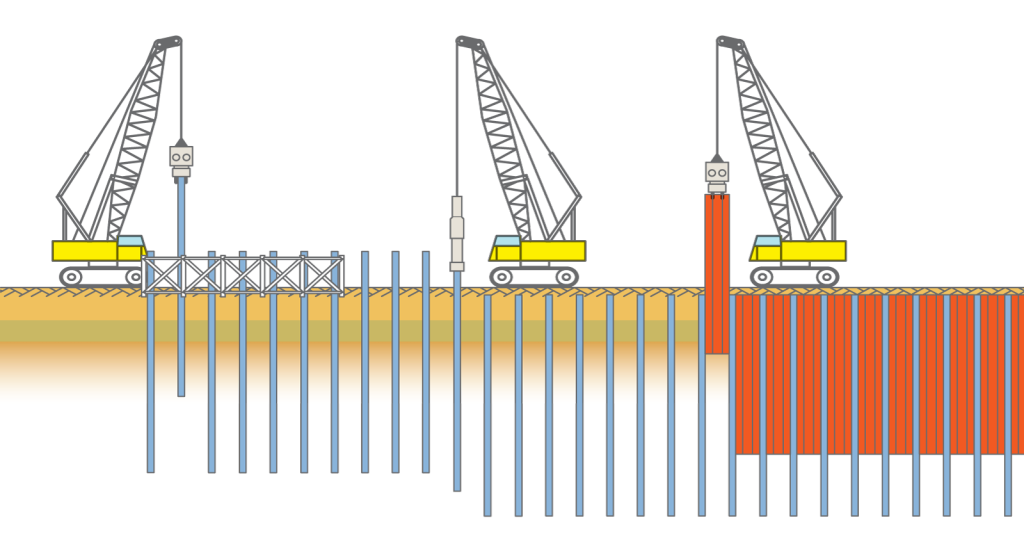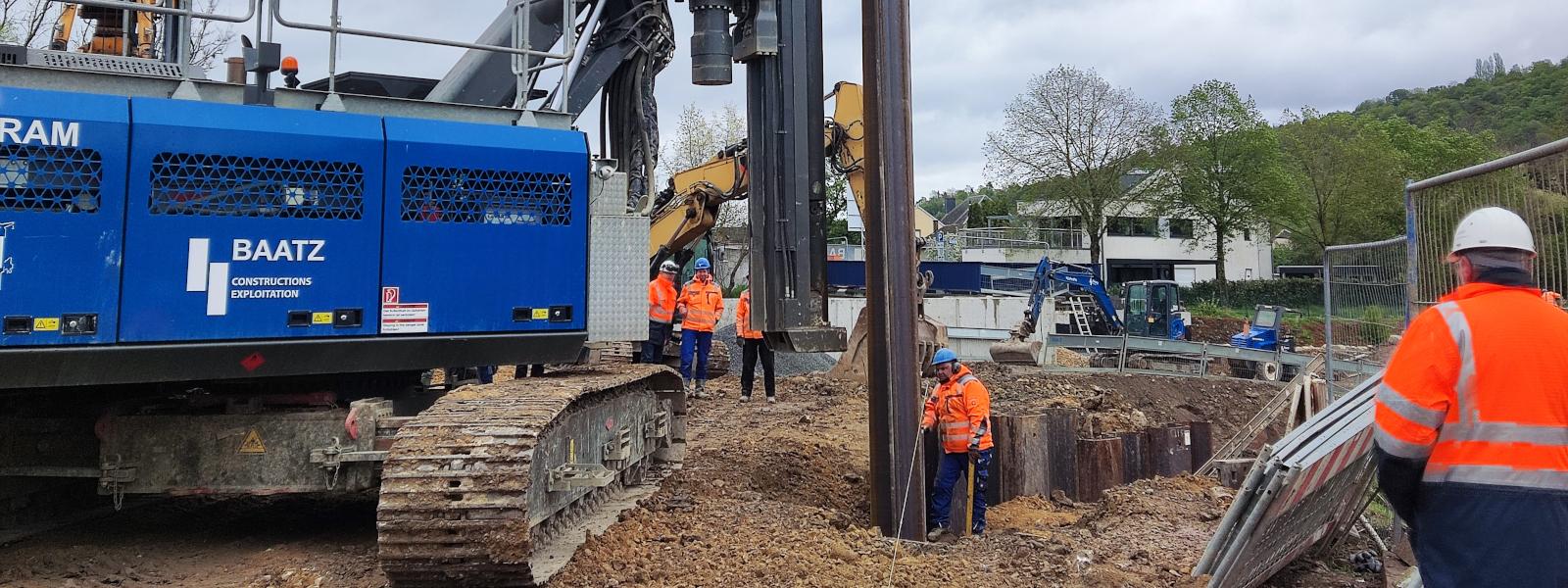Installation - Acolad
Installation of Steel Sheet Piles
Installation
It is possible to drive sheet piles into any type of soil except rock, but steel sheet pile installation is a quite complex topic that should be handled by experienced professionals. Installation shall consider the whole system: sheet pile, soil, pile driving equipment, driving template and if required, driving assistance. Additionally, a piling job can only be successful if it is based on an extensive soil investigation. This is the basis! If you are new in the business, seek help from experienced professionals before you start, especially for the installation of king pile systems and circular cells.
The selection of the sheet pile size must be based on the static design and on driveability in the given geological conditions. Installation speed and the allowable environmental impact on the surrounding area will depend also on the type of piling equipment.
Today the standard installation techniques use
- vibratory hammers,
- impact hammers,
- presses.
Driving assistance is either water-jetting, pre-drilling or pre-augering, blasting (quite rare).
Other special installation techniques exist and can be beneficial if certain site conditions prevail.
Execution speed varies significantly with ground conditions, sheet pile length and driving equipment. Generally speaking, the execution speed of standard sheet piles lies anywhere between 6 pairs and 30 pairs a day.
Execution of circular cells or diaphragm cells using AS 500 sheet piles is more complex (see link to our webpage below).
The installation of an HZ-M combined wall system must follow a specifc procedure. It requires a rigid two-level template, or a driving equipment fixed to a leader and a guiding frame.
For details on these more specific installation methods, see our Piling Handbook, our AS 500 brochure, our HZ-M steel wall system brochure, and our Installation manual. Watch the video animations on our YouTube channel (click here)

Installation equipment
The choice of the pile driving equipment shall consider the whole system: sheet pile, soil, driving template and if required, driving assistance, nuisances (noise & vibrations). Additionally, a piling job can only be successful if it is based on an extensive soil investigation. It is possible to drive sheet piles into any type of soil (except rock), but steel sheet pile installation is a quite complex topic that should be handled by experienced companies.
The selection of the sheet pile size must be based on the static design and on driveability in the given geological conditions. Installation speed and the impact on the surrounding area will depend predominantly on the type of piling equipment.
Today's standard installation techniques use
- vibratory hammers (resonance free, high frequency,...),
- impact hammers (diesel, hydraulic, free fall, rapid blow,...),
- hydraulic presses (self-walking, rig-mounted).
Other special installation techniques exist and can be beneficial if certain site conditions prevail.
Vibratory pile drivers
The principle of vibratory pile driving is the reduction of friction between the pile and the surrounding soil. The vibrations cause a temporary localized liquefaction, which results in a noticeable decrease of resistance between soil and pile. This enables to drive the pile into the ground with a light equipment. The vibratory driver generates oscillations inside a vibration case by rotating eccentric weights. Most vibratory hammers are nowadays powered by hydraulic pressure, whereas in the past they had also electric engines.
Vibratory hammers are quite effective in granular soils, such as sands and gravel. In clays and very compact granular soils, powerful vibratory hammers with a high amplitude can also be used, but impact hammers may be required to drive the sheet piles to final depth.
Modern vibrators are equipped with variable eccentric weights that allow resonance-free start-up and stop-down, which is especially important if sheet pile works have to be done near existing sensitive structures and buildings.
Hydraulically operated clamps ensure a secure fixing of the pile under the vibro and allow proper transmission of the driving energy into the pile. The crane holding the vibratory driver is isolated from the vibration case by rubber cushions or spring elements. A distinction is made between standard and high frequency vibrators. The most suitable equipment shall be selected based on given soil conditions and geographical situations. For example, the use of high frequency vibrators is advisable if vibration on adjacent buildings have to be minimal.
The vibrators can be used free-hanging from a crane or mounted on a leader system, the latter allows additional pull-down forces.
For short and light piles, driven in soft soils, excavator-mounted vibros are an option.
In case of temporary use, the sheet piles can be pulled out again by the vibrating technology or special pile pulling machines.
Hydraulic hammers
There are two types of hydraulic impact hammers (hydrohammers) : single and double acting.
An hydraulic hammer consists of an enclosed ram which is lifted by hydraulic pressure. On the downward stroke either the ram is driven by gravity, or additional energy is delivered, producing an acceleration of up to 2g for the double acting system. The maximum stroke of 1 meter thus corresponds to a free fall drop of 2 meters.
The hammers range from a minimum energy/blow of 35 kNm to 3000 kNm with a blow rate of 50/60 blows per minute. The electronic control system ensures optimum control of the piling process. The net energy applied to the pile which is measured during every blow and shown on the control panel can be continuously regulated from maximum to less than 5%.
Hydrohammers can operate at any angle, above or below water. They are suitable for driving and extracting piles. Under normal site conditions it is usual to select a ram weight that is in the ratio 1:1 to 1:2 with the weight of the pile plus driving cap. A heavy hammer with short drop is always preferable to minimise pile head damage and noise level emissions.
For standard steel sheet pile driving hydrohammers from 35 kNm to 90 kNm energy per blow are best suited. Larger hammers can be used to install the king piles of a combined wall.
Rapid blow hammers
In rapid blow hammers the striking ram (piston) is driven by compressed air when rising and falling. Steam hammers are no longer in use.
The air arrives under pressure in a valve box containing a slide valve which sends it alternately to each side of the piston, while the opposite side is connected to the exhaust ports.
When falling, the striking mass hits a flat anvil fixed to the cylinder resting on top of the pile being driven. Then the pressure lifts the piston up and allows it to be forced down again on to the anvil.
In comparison with drop hammers of the same capacity, the ram weight of a rapid blow hammer is much lower: it is only 10-20% of the overall hammer weight but is effectively increased by the higher pressure (5-8 bar) on the upper end of the piston.
The hammers are designed to operate at maximum efficiency when used with standard compressors.
Hydraulic sheet pile presses
If vibration and noise are a critical issue for sheet pile installation, for example near sensitive buildings in urban areas, or close to railway lines, the use of a pressing machine should be considered.
The self-walking pressing machines demand only limited space. They are clamped onto already driven piles and are able to install single and double Z- or U-piles, also in corners and circles. To start the operation, an auxiliary frame, ballasted with additional weight (normally sheet piles) can be used.
The machines are especially well suited for use in slightly cohesive soils, are hydraulically operated and take their reaction force from the friction of the previously driven piles. Additional pre-drilling or water jetting can be applied.
Another type of pressing machine is the leader-guided press. As a standard, it is equipped with two, three or four cylinders. The piles are set in a panel under the machine and pressed one after the other into the ground. In the beginning, the rig acts as a counter weight. In a second phase, the deeper the piles are pressed, the more skin friction is taking over the reaction part.
The maximum pressing depth depends on soil conditions, pile size and machine power, and lies around 15 - 18 m.
Driving assistance
Driving assistance should be considered in cases where it is not possible to use heavy equipment, or to reduce vibrations and noise:
- water-jetting,
- pre-drilling or pre-augering,
- blasting.
You can find more details in the 'Piling Handbook' and in the 'Installation manual'.

